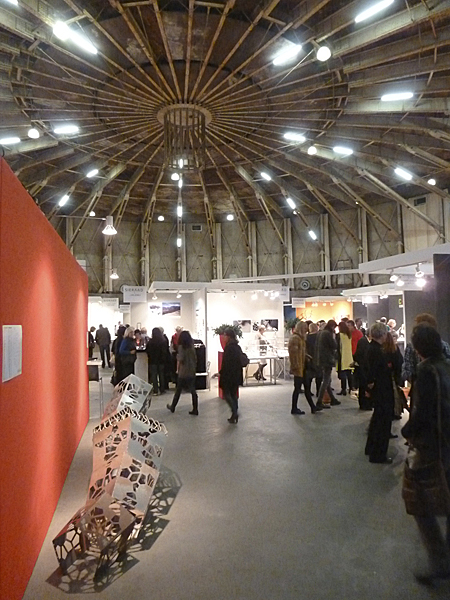
November 7–10, 2013
Every September, the Gashouder (“gasholder’”) in Amsterdam is a bit like the biblical Tower of Babel. During the Sieraad (“jewel”) International Jewellery Art Fair, many languages are spoken by both the participating artists—of whom only 35 percent are Dutch—and the visitors—of whom, according to the organization, 35 percent come from abroad. This year was the 12th edition of the fair, and the sixth time that it took place in this historical industrial building. Sieraad was originally intended as an alternative to “the petty art world dictated by gallerists and curators” as the organizers define it on the Dutch language pages of its website. Artists are its primary clientele and are eager to participate: 450 applied, while only 185 were granted a booth. The organizers Astrid and Maarten Berens (EMB&B Art Events) oversee the selection, focusing on quality, diversity, and steady participation. Similar to previous years, a remarkable 25 to 35 percent of participants were new. The fair does seem to fulfill a need. More than 7000 people visited it this year, prolonging the event’s steady yearly growth.
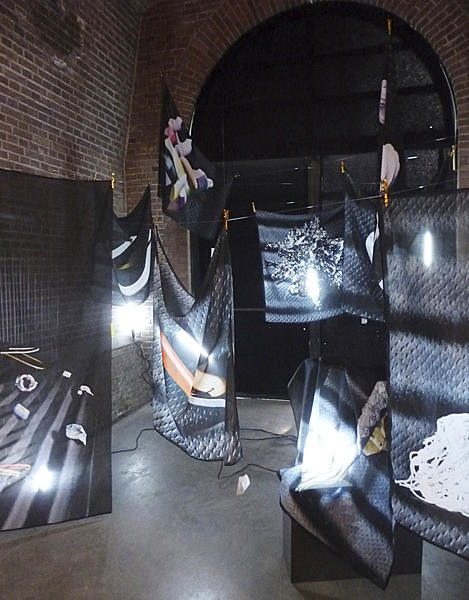
In the past, some enthusiastic young jewelry makers ran an “off” program throughout the city, featuring open studio exhibitions and special presentations at different locations and incorporating Amsterdam’s major jewelry galleries. For a brief moment, the excitement ruling Munich in March seemed to dawn on Amsterdam, but unfortunately, the initiative proved to be far too labor intensive. Nowadays, the fair has become a quite autonomous affair. The program does not mention the main jewelry shops and galleries in the city or the permanent jewelry displays at the Stedelijk Museum and the Rijksmuseum.
Artists
The work of the participating artists ranges from the traditional, made from precious materials with shiny surfaces and the occasional sparkle, to the experimental and unconventional. The most remarkable booth this year displayed pictures of mistreated animals and neckpieces with huge, heavy steel pendants hanging from uncompromising iron neckbands (Siegfried Büler’s Siggnatur).
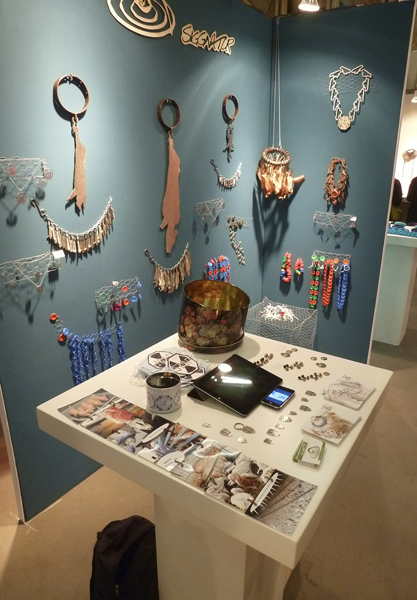
The recently published Contemporary Jewelry in Perspective needs the first chapter to define the subject of the book. Something that seems clear to many is hard to pin down in a convincing way. The main point is that a certain group of artists are prepared to disregard considerations about wearability, size, costs, materials, beauty, and all other conventions in favor of attaining their artistic goals. They are the makers that are the main interest of “gallerists” and “curators” and of a specific group of collectors and wearers. As Sieraad is advertised as “the international jewellery art fair,” one might assume that the work on display is the kind of avant-garde jewelry just described, yet most of the participants represent a different approach. For them, the potential buyer is their point of departure, not some adventurous artistic goal. Many of these artists make use of the vernacular of contemporary jewelry that was developed during the past decades, but tend to make it easier to wear and less obstinate and expensive. This difference in attitude in no way implies that they turn out inferior work, or that nobody would be interested in what they make, as the numerous visitors to the fair make sufficiently clear.
Given their ambition to get people interested in their jewelry, how successful a lot of the artists are at making life difficult for their potential customers amazes me. Naturally, a lot of effort was made to design a good presentation, but too many exhibitors burdened their walls and tables with a profusion of pieces. The modest size and the differently colored booths add to the general visual unrest. The intriguing ring by Jillian Moore, featured on the cover of the magazine-like fair catalog, was drowned on her exhibition table by an over-abundant amount of stock. This is always the big problem with displaying jewelry. The objects are small, and they demand time and space to be appreciated. On the other hand, the cost of participating in a fair makes selling an urgent issue. A lot of work is priced moderately, and in this context, you can hardly afford to put just solitary pieces in the vitrines. The visitors to the fair, however, seem undaunted. Many start their day at the opening time of 11:00 in the morning and continue until the fair closes at 6:00pm. Some even buy a three-day pass.
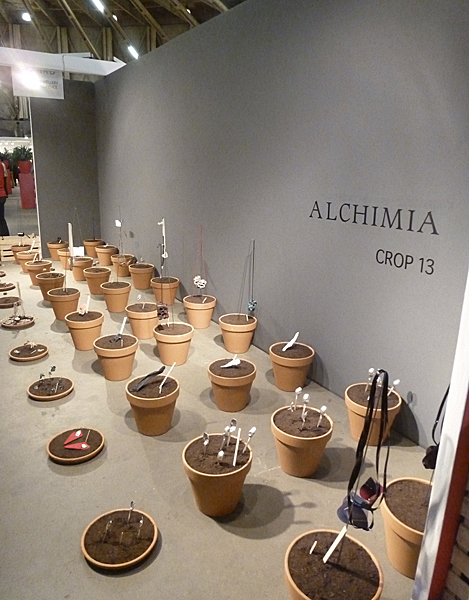
Schools
Academies also face the problem of how to exhibit a representative selection of work made by their students. They usually manage to cope with this in a successful way, and to me, the student presentations are often the most interesting part of the fair. This time, the results were mixed. The stand from the academy (Fachhochschule) in Düsseldorf seemed a miniature version of Sieraad itself with a lot of small work on tiny tables. The Maastricht Academy of Fine Art and Design had clearly made a rigorous selection and had invested a lot of attention in their presentation, but the forbidding black curtains across the entrance of the stand—behind which one could see large photographs of a stout nude woman embellished with silver objects between her layers of skin—made for a mixed reward. In contrast, the Irish jeweler Samantha Hamilton had cleverly turned the booth of Alchimia, from Florence, into a real hothouse, using actual terracotta pots and resulting in an eye catching stand with sufficient attention for each individual artist. Antwerp’s two jewelry departments were present at the fair. The Royal Academy of Fine Arts showed an interesting wedding ring project initiated by Ted Noten, though the many, amusing pictures of Noten with his wife-to-be were perhaps a bit of an insiders’ joke. The addition of a lot of other pieces was rather interfering with the main subject. Sint Lucas chose perhaps the most radical approach, with a nice idea, convincingly executed. Instead of showing actual jewelry pieces, they built a kiosk decked with a wide selection of actual fashion and lifestyle magazines. These publications were customized with transparent stickers embellishing several of the featured women with jewelry pieces made by students. The circulation of these magazines in as many living rooms and waiting rooms as possible should increase awareness and enthusiasm for contemporary jewelry.
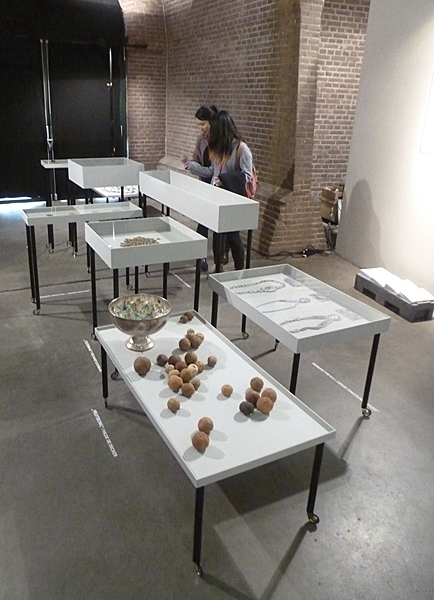
The organization invited the Bucks&Barter project—an initiative from Beatrice Brovia, Nicolas Chang, Friederike Daumiller, and Katrin Spranger—to show at Sieraad. Earlier this year, they exhibited during Schmuck in Munich. Next to their own pieces, they displayed a selection of work by recent graduates, and they produced a Bucks&Barter catalog. This is what contemporary jewelry is about, and this was it in its most radical guise. Understanding each piece, if it took the shape of jewelry at all, required either substantial explanations or a very willing eye. I liked the project very much because it appealed both to the senses and to the brain, but I doubt whether the fair’s regular visitor, already exhausted by the overload of visual information, could appreciate it. (I understood many of the pieces only afterwards when reading the catalog.) Talking about harsh realities, it is as telling as it is sad that this uncompromising way of thinking about jewelry could only come into existence because it was subsidized: first in Munich for the 2013 international fair; and again for this edition of Sieraad in Amsterdam.
Conclusions
At Sieraad, makers and consumers are very happy to have the opportunity to meet and do business. The fair even works as a wholesale event, where shops from around Europe stock up for the year to come. So, it is clear that the fair is an opportunity welcomed by many—certainly by all the visitors who show up year after year, possibly less so by the artists. The large number of new participants each year is a clear indication that not everybody leaves Amsterdam satisfied. The space is special, the booths and layout are professional, extras like the catalog and a restaurant are available, and the atmosphere is lively. But, there are no galleries participating and none of the internationally known, leading jewelry artists. So, don’t expect a miniature, Dutch version of Munich’s Schmuck or London’s Collect. With this anticipation, you are bound for disappointment, for this is a different realm. If you are keen on seeing, and possibly buying, a great diversity of affordable, “modern” jewelry, you’ll have a field day at Sieraad.




